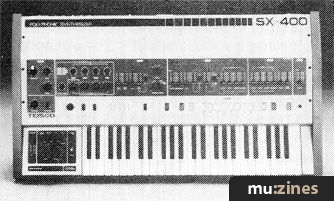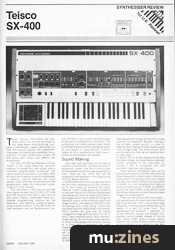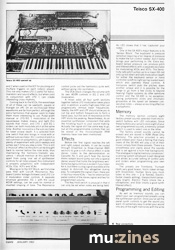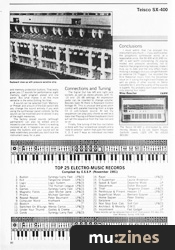Magazine Archive
Home -> Magazines -> Issues -> Articles in this issue -> View
Teisco SX-400 | |
Article from Electronics & Music Maker, January 1982 | |

Teisco musical instruments are relatively new in the UK and are made by the large Kawai manufacturing company in Hamamatsu, Japan, well known for their fine acoustic pianos. The comprehensive range of professionally presented Teisco products includes synthesisers, mixers, PA and group gear amps, plus effects and accessories.
The Teisco SX-400 Synthesiser is the top model in the range featuring computer memory for preset and user voices, plus a complete programmable synthesiser that can be edited and played on up to four notes at once from its pressure sensitive keyboard. In addition, special features like touch sensor, hand controller, ensemble and note assignments make this instrument something out of the ordinary.
The instrument is well laid out with the main panel divided into LFO, VCO, VCF, VCA and HPF sections from left to right. Also on this panel directly underneath these synthesiser programming controls are the keyboard, note selection, preset programming and edit buttons. To the left of the 49-note keyboard, are the 'performance' controls. All the in/out connections are located at the rear including the on/off switch. The synthesiser's all metal cabinet is well made to withstand knocks without being too heavy for one person to carry around. Unfortunately, no lid is supplied so a flight case or similar would probably be needed.

Teisco SX-400 opened up.
Sound Making
Let's start with the basic sound making controls on the SX-400. Like most varieties of polyphonic synths, one set of controls sets the parameters for all the notes played at any time. There are four VCOs that can be assigned to the keyboard in four ways using the Poly Mode switches: 1) QUAD where one VCO is assigned to each key at a time, allowing you to play chords of up to four notes by pressing four keys. Channel 1 pitch/range group has its LED lit to indicate that all four VCOs will be adjusted simultaneously from its rotary pitch control and range switch. Each mode will bring into operation one or more of the four pitch and range controls, indicated by the LEDs in the four groups and a 'total tuning' control sets the overall pitch to match other instruments. Pitch controls will give over an octave change and range switches select 16', 8', 4' and 2' basic keyboard pitch. Only channel 1 range setting can be stored in the memory.
2) DUAL mode assigns two VCOs to one key at a time, with a maximum two notes playable. Channel 1 and 2 pitch/range controls let you detune the two pitches and set individual ranges too. The oscillator sound is therefore much richer and great for semi poly/mono solos.
3) MONO puts all four VCOs on to a single note played and brings all the pitch/range controls into operation. Besides creating a big oscillator unison sound, it is ideal for making fixed interval chords, played easily from a single note. The levels of each VCO are the same but filtering can balance them in many ways.
4) SOLO. This is a little disappointing after the other modes, but nevertheless does add further versatility to the instrument by turning it into a monosynth with 'one oscillator/one note' only playing.
These options immediately open up the playing styles and I found that I was selecting these frequently to match solos, chords and instruments. For example, the 'violin' preset can be a solo violin in SOLO, a string quartet in QUAD, or a rich vibrating (from detune) string orchestra sound in DUAL and MONO. Going one step further, using QUAD mode with ensemble gives a superb stereo phased image of a string section.
There are two LFOs on the instrument — still quite a luxury for most machines without patching facilities. LFO 1 has a wide range frequency control giving an adequately slow sweep to a fast 14 cycle 'buzz'. Four waveshapes are available — sawtooth, inverted sawtooth, square and triangle. Incidentally, using triangle instead of sine for LFO control often gives a more natural tremolo and vibrato. A delay control will give up to a second or so pause on new keys before the effect begins. Polyphonic upward and downward slides, trills, wah-wah, tremolo, vibrato and echo-like effects can all be obtained.
LFO 2 gives a triangle wave modulation to the VCF section only. It can also trigger EG 1 and 2 when used on the VCF for plucking and multiple triggers on each note(s) played. This not only makes LFO 2 useful for banjo, mandolin and sound effects, but when used in conjunction with LFO 1 can create interesting cross rhythms.
Coming back to the VCOs, the waveshape of all of these can be sawtooth, square or triangle (or off). On an oscilloscope these waveforms are far from perfect, although the extra harmonics that appear seem to make them more interesting to use. Pulse width manual or LFO/EG 1 modulation of the square wave makes brassy and tight thin sounds that 'move', and LFO 1 and EG 1 sliders can both modulate pitch at the same time. Another nice extra is the sub oscillator for lower octave depth. It is selected from one switch that also brings in noise with or without sub oscillator. EG 1 control of pitch is not common on polyphonies, yet it opens up plenty of experiment with pitch sweeps and jumps each time you play a note. This is still a 'musical' effect as the pitch can be brought back to normal before the note ends, thus maintaining the harmonic/melodic sequence. I should mention at this point that apart from using 'one' set of synthesiser controls for all notes played, this instrument is properly polyphonic with independent VCOs, EGs, VCFs and VCAs.
Moving on to the VCF Block, we find a low pass filter with Cut-off, Resonance, Keyboard Control Voltage (follower) and LFO 1 or 2 modulation slider controls. A separate envelope generator, EG 1 with the usual ADSR settings, can be used for normal or inverted shaping of tone. The Resonance control picks out the harmonics quite well, without going into oscillation.
The VCA block changes the volume with its own ADSR controls in EG 2 and LFO modulation.
A mixer adds all four synth sections together before LFO modulation takes place and, in addition, a useful high pass filter can progressively remove lower frequencies. Ideally, the HPF and LPF should allow you to cut top and bottom frequencies to form a band pass, but the lack of resonance on the HPF limits the peaking. Nevertheless, its an essential synthesiser component that adds the finishing touch to your sound making. Actually the signal still has some way to go, but all the programmable controls that can be stored in the microcomputer RAM memory have now been mentioned.
Effects
Before the 'line' signal reaches the left and right output sockets, it can be routed through Ensemble (a three-channel BBD section) to give a rich chorus effect in wide stereo. Listen to the demonstration on Cassette No 5 and you'll hear the normal mono output sound jump out into a spatial stereo sound that holds the brightness well. Some background hiss is evident if you listen for it, but there is a big signal available at the output to diminish this altogether during play. To complete the signal chain, there are in fact four more VCAs — two for external foot pedal control of the stereo signal and two for programmed volume.
The Key Hold switch is unusual in that it can only be set when notes are being held. An LED shows that it has 'captured' your notes.
One of the SX-400's major features is its 'Sensor Block'. The keyboard is pressure sensitive requiring a fair degree of pressure to make the full control 'sweep', but it really brings your performing to life. Extra keyboard sensor pressure can produce pitch and filtered effects with a separate oscillator for modulating VCOs and VCFs. The Sensitivity sets pitch jumps up to a major 6th not only up but down and sets modulation depth for either the keyboard sensor or hand controller (a left-to-right spring-loaded lever) which also operates these controls. A transpose switch puts the pitches down another octave and it is possible for the range to go from a few clicks to beyond hearing! Digital systems do offer semitone control and the SX-400 is no exception, having portamento slides and chromatic glissandos at the speed set between consecutive notes — always an exciting effect on a polyphonic.

Keyboard close-up with pressure sensitive strip.
Memory
The memory section contains eight factory preset sounds selected from microswitch buttons with LED indicators. Since these buttons also serve to store eight of your own programmed sounds, a memory/preset switch is used to select one or the other.
The factory preset sounds cannot be erased and are stored in ROM (Read Only Memory). The selection provided is very good indeed and I have a feeling that many users of the SX-400 will play a lot of their music simply from these presets. There is a smoothness and clarity about the sounds that is set against a hum free background. The analogue to digital memory conversion/scanning system employed is well designed and allows accurate setting of control pots and sliders when programming your own sounds.
The presets are Trombone, Trumpet (both very good brass), Violin (ideal strings with Ensemble), Human Voice (you must listen to this one — a la Tomita), Electric Guitar (needs editing), Harpsichord (amazingly bright), Electric Piano (more like a vibraphone), and Sitar (really a good synth filtered effect).
Programming and Editing
As well as 'memory' sounds, you can select your own programmed presets using the synthesiser section. Once you've set the panel synth controls to get the sound you want, it's extremely easy to enter your sound into any of the eight memories with the write and memory protection buttons. That really gives you 17 sounds for performance: eight memory, eight program preset and one panel. But what makes it all the more versatile is the extra Editing facilities.
A sound can be selected from 'Memory' or 'Preset' and a touch of the Edit switch lets you change the sound entirely if you wish using the synthesiser panel controls. So the sound can be modified and re-stored in any of the eight memories.
The factory preset sounds (although permanent) can also be edited and/or moved to user memories. There's no waiting involved at all, it happens as soon as you press the buttons and your sound will be held indefinitely provided you don't lock the instrument away for a year.

Rear connections.
Connections and Tuning
The Signal Out has left and right jack sockets, as well as stereo phones, with +4, -10 and -20dB settings. An expression pedal can be inserted to change volume. Besides Gate IN there is Keyboard Control Voltage IN. This is unusual and gives pitch control with parallel tracking from a single CV (1 volt/octave) source. At last my sequencer can play poly chords as well as a bass line! Playing a different keyboard chord will set the sequence from the new root and so on.
Finally, fine tuning of the four oscillators is done with four screwdriver presets and a 'note A selector' switch that puts the lowest C, D, E and F keys as individual oscillator unisons.
Conclusions

I must admit, that I've enjoyed this instrument very much — if you want to enter the polyphonic synthesiser world, at a reasonable price, the SX-400 at £1,690 inc VAT is well worth considering. Its playing modes and pressure sensitivity, not to mention the programming features, make it truly up to date and the only effect that's missing is arpeggio (but you can get that with an external CV/Trigger). I've recorded the Rick Wakeman music from the December issue on it (using the eight-track Fostex) as well as plenty of other sounds on Demo Cassette No 5, and the quality of the sounds is superb. You probably won't even know it's only playing four notes!
The Teisco SX-400 is distributed by John Hornby Skewes & Co Ltd, (Contact Details).
Also featuring gear in this article
Browse category: Synthesizer > Teisco
Publisher: Electronics & Music Maker - Music Maker Publications (UK), Future Publishing.
The current copyright owner/s of this content may differ from the originally published copyright notice.
More details on copyright ownership...
No Javascript: Audio player is disabled
Side A Tracklisting:
00:00 Intro (Teisco) 03:31 Teisco SX-400 Synth. 04:01 - SX-400 [1] 04:32 - SX-400 [2] 04:45 - SX-400 [3] 04:56 - SX-400 [4] 05:17 - SX-400 [5] 05:43 - SX-400 [6] 06:18 - SX-400 [7] 06:30 - SX-400 [8] 06:43 - SX-400 [9] 07:04 - SX-400 [10] 07:17 - SX-400 [11] 07:45 - SX-400 [12]
E&MM Cassette #5 provided by Pete Shales, digitised by Mike Gorman.
Review by Mike Beecher
Help Support The Things You Love
mu:zines is the result of thousands of hours of effort, and will require many thousands more going forward to reach our goals of getting all this content online.
If you value this resource, you can support this project - it really helps!
Donations for October 2025
Issues donated this month: 0
New issues that have been donated or scanned for us this month.
Funds donated this month: £0.00
All donations and support are gratefully appreciated - thank you.
Magazines Needed - Can You Help?
Do you have any of these magazine issues?
If so, and you can donate, lend or scan them to help complete our archive, please get in touch via the Contribute page - thanks!







